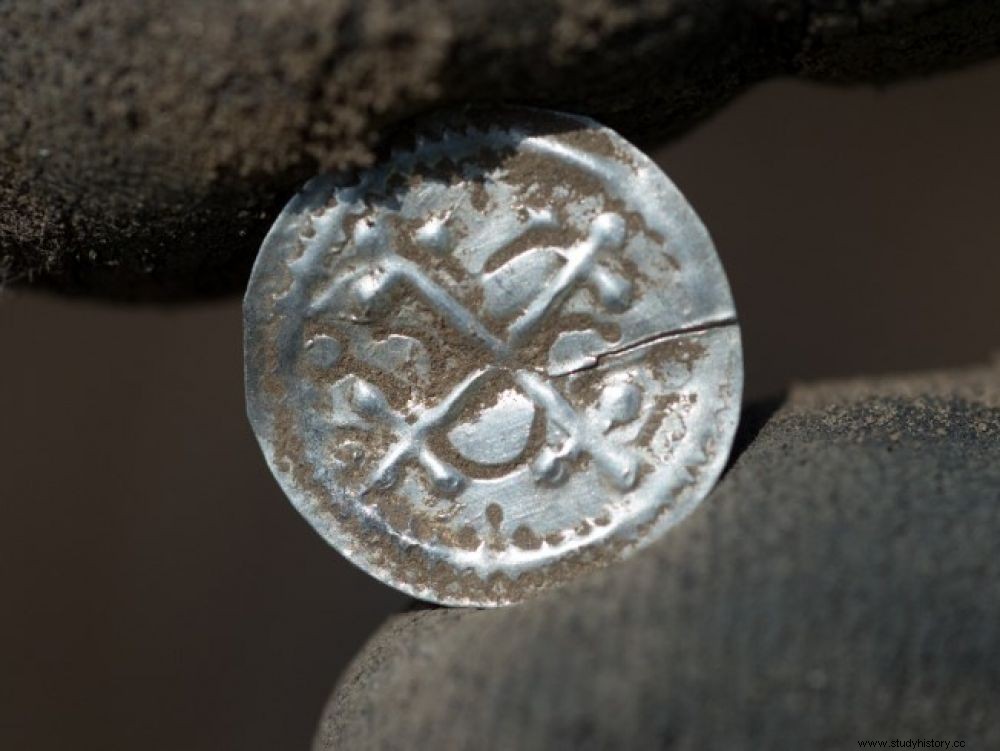Metal detectorists, including a 13-year-old child, discovered a treasure on the German island of Rügen that may have belonged to the Danish king Harald Bluetooth.

Silver coinage from a monetary "hoard" linked to Danish King Harald Bluetooth.
Nearly 600 silver coins, a hammer of Thor, brooches, rings or even a braided torc... constitute the highly publicized "hoard" unearthed in a field located on the island of Rügen (Germany), at sea Baltic, due to the presence of a thirteen-year-old child among the "treasure hunters", as reported by the German press agency DPA Monday, April 16, 2018. Located in January 2018 by metal detectorists (see box ) near the locality of Schaprode, the archaeologists – who had been alerted – carried out its release during the weekend of April 14 and 15. According to the first expertise, this important discovery could date from the kingdom of Harald 1 st (910-987), sovereign then reigning over Denmark, northern Germany and southern Norway. Better known as Harald of the Blue Tooth - due to a spoiled tooth, this unifying king became famous for his rejection of ancient Viking beliefs and the Christianization of Denmark.
Most coins date from the X th century (read box ). But other, older coins from distant lands have also been unearthed as frequently in Viking treasures, like this Damascus Dirham dated 714, transformed into jewelry. This deposit could have been concealed by Harald I's entourage following a battle waged against his own son, Sven Gabelbart, in 986. The sovereign was then forced to flee to Pomerania, where he died a year later. late. "We have here the case of a rare discovery that seems to be linked to historical sources ", explained Detlef Jantzen, the archaeologist responsible for the Mecklenburg-Eastern Pomerania region. Jewelery dating from this same period had already been discovered not far away, on the island of Hiddensee, at the end of the 19 th century. century. Remember, for the record, that if Harald the blue tooth became famous, it is also because of his runic initials HB - for Harald Blatand (Gormsson) - became those of the Bluetooth wireless technology ("blue tooth") logo.
With AFP
Metal detectors, different European legislation depending on the country
In France, unlike Germany where the discovery of this monetary treasure dating from the time of King Harlad 1
st
has been made, article L.542-1 of the Heritage Code on the use of metal detectors aims to better protect the archaeological heritage. “ No one may use equipment allowing the detection of metallic objects, for the purpose of researching monuments and objects that may be of interest to prehistory, history, art or archeology, without having, at least prior, obtained an administrative authorization issued according to the qualification of the applicant as well as the nature and methods of the research ". Failure to comply with this article is punishable by the fine applicable to fifth-class offences. Since 2016, the archaeological objects are now public property. However, in case of "treasure", compensation is provided.
The presence of Arab coins in Viking treasures
The Vikings reached the Black Sea and the Caspian Sea between 800 and 1050, thus coming into contact with the Byzantine Empire and the Islamic Caliphate. Manuscript sources even establish that between the 9th and 10th centuries, the Norwegian Vikings had established commercial relations with these regions. And what mainly attracted the Nordics to this part of the world was money. Not fiduciary money, but the precious metal, used by weight in the form of coins, bars or cut into pieces. The flow of dirhams from the Islamic world found on the European continent was thus considerable. A taste that even pushed them to make copies! From the 9th century, the Vikings, who did not mint coins, adopted the metal of silver as a medium of exchange but used it first to display their personal wealth, as indicated in his texts by the scholar Arab Ibn Fadlân, in the tenth century.



